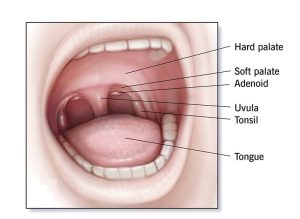Adenoidectomy (Adenoid Removal)
Adenoid glands are part of the immune system and help protect the body from viruses and bacteria. An adenoidectomy is a surgery to remove the adenoids because they have become swollen or enlarged because of an infection or allergies. Adenoids located in the back of the mouth.

What are adenoids?
Adenoids are glands located above the roof of the mouth, behind the nose. They look like small lumps of tissue, and serve an important purpose in young children. Adenoids are part of the immune system and help protect the body from viruses and bacteria. Adenoids begin to shrink around age 5 to 7 in children, and can be almost completely gone by the teenage years.
What is an adenoidectomy?
An adenoidectomy, or adenoid removal, is surgery to remove the adenoid glands.
While adenoids help protect the body from viruses and bacteria, they sometimes become swollen and enlarged or chronically infected. This can be due to infections, allergies, or other reasons. Some children may also be born with abnormally large adenoids.
When a child’s adenoids become enlarged, they can cause problems by partially blocking his or her airway. When this happens, children can have breathing problems, ear infections, or other complications, which can lead to snoring or more serious conditions such as sleep apnea (stopping breathing) at night.
Chronic (long-term) nasal drainage, congestion and sinus infections can also be seen. Enlarged adenoids can also affect the recurrence (return) of ear infections and chronic fluid in the ear, which can result in temporary hearing loss.
Surgery to remove the glands is often needed. Removing them has not been shown to affect a child’s ability to fight infections.
An adenoidectomy is mostly done for children who are between the ages of 1 and 7. By the time a child is 7, the adenoids begin to shrink, and they are considered a vestigial organ in adults (a remnant with no purpose).
How does a doctor determine if a child needs an adenoidectomy?
If you suspect your child has an issue with his or her adenoids because of problems with breathing, ears, or recurrent sinus infections, you should consult your doctor. After taking a health history, the doctor will examine your child’s adenoids, either with an x-ray or with a small camera placed in your child’s nose.
Based on your child’s symptoms and if his or her adenoids appear enlarged, your doctor may recommend that the adenoids be removed.
PROCEDURE DETAILS
How is an adenoidectomy performed?
An adenoidectomy is a straightforward, relatively short procedure usually done on an outpatient basis by an ear, nose, and throat (ENT) surgeon. Your child will be placed under general anesthesia for the procedure.
During surgery, the doctor will widely open your child’s mouth with a retractor while the child is asleep, and then remove the adenoids using one of several techniques. The doctor may use an electrical device to help stop the bleeding.
Your child will then be taken to a recovery room until he or she awakens from the anesthesia. Most children will be able to return home on the day of their surgery.
RISKS / BENEFITS
What are the risks of an adenoidectomy?
The risks of an adenoidectomy are rare but include:
- Failure to resolve the underlying breathing problems, ear infections, or nasal drainage
- Excessive bleeding (very rare)
- Permanent changes in vocal quality
- Infection
- Risks from the use of anesthesia
Your doctor should thoroughly explain all of the risks of adenoid removal and answer your questions before you agree to the procedure.
What is the prognosis (outlook) for a child who has had an adenoidectomy?
After an adenoidectomy, a child almost always has a full recovery to a healthier life with far fewer breathing and ear problems. Your child may temporarily have a sore throat, earaches, bad breath, or stuffy-feeling nose as he or she recovers.


